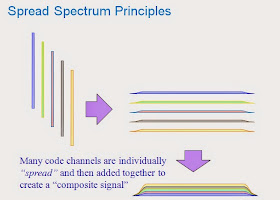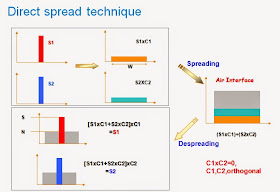Content:
n The Basic Principles of Wireless
Communication
l3G services
lMultiple
Access Technologies
lSpectrum
Planning
lSpreading
Technology
lCoding
And Interleave Technology
lModulation
n UMTS Radio mechanism
Radio Transmission Technology Requirements
nData:
l144
kbps High speed and driving
l384
kbps Modest speed and walking
l2
Mbps Low speed and indoor
nVoice
l4.75Kb/s
-- 12.2Kb/s
l64kb/s
(Video Phone)
nInformation transmission at variable rate
according to bandwidth requirements;
nDelay requirements of different service
3G services
Duplex Mode
nTDD mode-uplink and downlink has the same frequency
lAdaptable
to any frequency band
lSuitable
for both asymmetric and symmetric services
nFDD mode-uplink and downlink has the different
frequency
lPaired
frequency bands are needed
lSuitable
for symmetric services

Multiple Access Technologies
Multiple access technologies enable various users access public communication line but without interference.
nWhy Multiple Access?
lIncreased
capacity: serve more users
lReduced
capital requirements since fewer media can carry the traffic
lDecreased
per-user expense
nTypes of Transmission Medium:
lTwisted
pair
lCoaxial
cable
lFiber
optic cable
lAir
interface (radio signals)
nThree
methods are frequently used:
lFDMA
lTDMA
lCDMA
Each
pair of users enjoys a dedicated, private circuit through the transmission
medium, unaware that the
other
users exist.
FDMA (Frequency Division Multiple Access)
nFDMA
lTraffic
channels are assigned to different users at different frequency band, such as
TACS, AMPS.
nTDMA
- Traffic channels are assigned to different users at different time, such as GSM, DAMPS.
CDMA (Code Division Multiple Access)
nCDMA
lTraffic
channels are assigned to users at same time, same frequency band, but with
different code.
CDMA Application
nUsers are distinguished by scrambling codes
and OVSF codes
nSelf-interference system
nCDMA system is restricted to interference (GSM system is restricted to frequency resources)

Spectrum Planning
Spreading Technology
n Where,
C is capacity of channel, b/s
B is signal bandwidth, Hz
S is average power for signal, W
N is average power for noise, W
nIt is the basic principle and theory for
spread spectrum communications.
nUser information bits are spread over a wide
bandwidth by multiplying high speed spread code(chip)
nSpread signal bandwidth W wider than original
signal bandwidth Rb
Spreading Mode:
nDirect
sequence spread spectrum(DS-SS)
lBase band data is spread by
multiplication of pseudo-noise sequence and base-band pulse, the pseudo-noise sequence generated by the
pseudo-noise generator
lBER subject to Multiple Access
Interference and near-far effect
lPower control can overcome the
near-far effect, but it is limited by
power detection accuracy
lWCDMA uses DS-SS
nFrequency
hopping spread spectrum(FH-SS)
lData is transmitted in the random
channel by the carrier frequency hopping
lBefore FH again, data is
transmitted using traditional narrowband modulation
lNo near-far effect
Characteristics of Spreading Communication
nHigh anti-multi-path- interference capability
nAnti-sudden-pulse
nHigh security
nLower transmitting power
nEasy to implement large-capacity Multiple
Access Communication
nOccupy band wide
nComplex realization
Coding And Interleave Technology
Purpose of Channel Coding:By adding redundant information in the original data stream, receivers can detect and correct the error signal, and improve data transmission rates.
nChannel coding
lError-correcting
ability obtains by adding redundancy in the original data
lConvolutional
coding and Turbo coding (1/2,1/3) are
widely applied.
lIncrease
noneffective
load and transmission time
lSuitable
to correct few non-continuous errors
Principle of Interleave Technology
nadvantage
lInterleave
is to change the sequence of data to random the unexpected errors
lAdvance
the correcting validity
ndisadvantage
lIncrease
the processing delay
lEspecially,
Several independent random errors may intertwined for the unexpected error.
Encoding and Interleaving
Modulation
nDefinition
lModulation
is the process where the amplitude, frequency, or phase of an electronic or
optical signal carrier is changed in order to transmit information.
lUsing
symbol stand for one or more bits to improve communication effectiveness
nClassification
lAnalog
Modulation
lDigital
Modulation
Analog Modulation
nThe purpose of analog modulation is to
impress an information-bearing analog waveform onto a carrier for transmission.
lCommon
analog modulation methods include:
nAmplitude
modulation (AM)
nFrequency
modulation (FM)
nPhase
modulation (PM)
Digital Modulation
nThe purpose of digital modulation is to
convert an information-bearing discrete-time symbol sequence into a
continuous-time waveform (perhaps impressed on a carrier).
lBasic digital modulation methods include
nAmplitude
shift Keying (ASK)
nFrequency
shift Keying (FSK)
nPhase
shift Keying (PSK)
UMTS Data transmission Procedure
Channel Coding of UMTS
Convolutional Code
nMainly used in the voice channel and control
signal channel
nCoding rate is ½ and 1/3.
Characteristics of Convolutional code
nEasy decode
nShort delay
nGenerally use the Viterbi
Algorithm
nChannel bit error rate is 10-3 magnitude
nSuitable to realtime service
le.g.
speech and video service.
Turbo Code
nUsed in Data service channel
nCode Rate is 1/3
nCan be implemented in the transmission for
large block and long delay services
nTurbo coding structure is based on two or
more weak error control code combinations. The information bits are interleaved
in the two Encoder, and generate two information flow. At last, this
information can be multiplexed and punctured
nDecoding needs cycle iterative calculation
Characteristic of Turbo Codes:
nComplex decoding
nUse the LOG-MAP arithmetic
nChannel bit error rate is 10-6 magnitude
nVery suitable to non-realtime
package service which is BER sensitive & delay insensitive, e.g. WWW, FTP, E_mail, multimedia transmission.
Spreading Technology of UMTS
Channelization Code
nAdopt OVSF code
lDefinition:
Cch,SF,k,
describe channelization code, where
SF : spread factor, k :
code number, 0 < k
Scrambling Code
nUMTS Scrambling code is pseudo random binary sequence
lIt has similar noise array
character, seemingly random but with regularity.
lCan make the user data further
random , strengthened by scrambling a code to keep secret the user data, at the same time easy to carry out multiple
access communication.
nUMTS scrambling code is generated from Gold
sequence
lGold sequence has excellent
self-correlation.
lCross-correlation is very week
between two codes.
lIt is used to identify cell and
user for multiple access.
Characteristic of Scrambling Code
nThere are
224 Uplink Scrambling Codes, they are used to
distinguish different users in one cell.
nThere are
218-1
Downlink Scrambling Codes, used to distinguish different cells
lScrambling
codes usually used are the first 8192 codes, which are code 0,1,……,8191.
They are divided into 512 aggregations,each aggregation has 1
primary scrambling code (PSC) and 15 secondary scrambling codes (SSC).
lThe
512 primary scrambling codes are divided further into 64 primary scrambling
code groups , with 8 primary scrambling codes in each group.
Code Function
nChannelization code ---- for separation of
physical channels in the uplink and separation of users in the downlink
nScrambling code ---- for separation of
users/terminals in the uplink and cells/sectors in the downlink.
Spreading code & scrambling code
nCch:spread code
lRelative
to service rate,extended to 3.84Mchips/s
lA
kind of orthogonal code
nCscrambling:scrambling code
lHave
no effect on signal bandwidth
lDownlink
for identifier cell,uplink identifier terminal
lA
pseudo-random sequence
nPG=Wc/Rb (Wc :
Chip rate , Rb :
Service bit rate)
lTransmitter/receiver
can obtain gain after spread/despread
lThe
narrower original signal bandwidth, the larger Pg , the better
The higher PG, the more anti-interference capability system
has.
Relation between Eb/N0 and PG
Modulation of UMTS
nBPSK (Binary Phase Shift Keying) in Uplink channles
nQPSK (Quadrature Phase Shift Keying) in Downlink channels
n16QAM (16-state
Quadrature
Amplitude Modulation) in HSDPA
End of UMTS Radio Theory Course





































